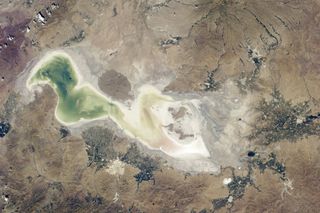Dead Volcano, Dying Lake Seen from Space (Photo)

A volcano that once poked out of a salty lake in Iran now sits on the shores of the drying body of water.
This extinct volcano sits by Lake Urmia, one of the largest lakes in the Middle East, according to NASA's Earth Observatory, But Lake Urmia is shrinking rapidly. Today, it holds only about 5 percent of its maximum volume. In 2013, only 20 percent of the normal surface area of the lake remained after the dry season, according to an Iranian Department of Environment report from March 2014.
"The Lake has almost entirely lost its ecological functions, while the ecological conditions of many satellite wetlands is also in great danger," the report concluded.
Now, the Department of Environment is working to save this salt lake, which is both a national park and a UNESCO biosphere reserve. The lake historically has been home to a dazzling array of birds, including flamingos and pelicans, according to UNESCO. The loss of water has driven many of these birds away. Meanwhile, salty sand storms from the now-dry lakebed are causing health problems for people who live close to Lake Urmia, according to Iran's Department of Environment. Blowing salt can also land in agricultural fields, literally salting the earth and hampering the growth of crops. [8 of the World's Most Endangered Places]
Drought and human use of water have brought the lake to its current state. Dams upstream remove water before it has the chance to reach the lake, and growing populations in the region are ever thirstier. To reverse the trend, Iran's government committed $500 million in March to halt the drying of the lake and instigate recovery.
Saving the lake will require halting agricultural expansion and instituting water-saving techniques, according to Iran's Department of Environment. Meanwhile, plans are in place to construct dikes and dams to corral what little water is left in the lake in smaller areas, preventing water from flowing into shallow pools where it easily evaporates.
This image, taken on June 23 by an astronaut aboard the International Space Station, clearly shows some of the green agricultural fields that are contributing to the lake's decline. A white-gray splotch below the fields on the lake's lower shore is the city of Urmia. Across the causeway that cinches the narrow point of the lake is the extinct volcano cone. Salt flats ring what little water is left in the lake and dominate its south side.
Sign up for the Live Science daily newsletter now
Get the world’s most fascinating discoveries delivered straight to your inbox.
Editor's Note: If you have an amazing nature or general science photo you'd like to share for a possible story or image gallery, please contact managing editor Jeanna Bryner at LSphotos@livescience.com.
Follow Stephanie Pappas on Twitter and Google+. Follow us @livescience, Facebook & Google+. Original article on Live Science.

Stephanie Pappas is a contributing writer for Live Science, covering topics ranging from geoscience to archaeology to the human brain and behavior. She was previously a senior writer for Live Science but is now a freelancer based in Denver, Colorado, and regularly contributes to Scientific American and The Monitor, the monthly magazine of the American Psychological Association. Stephanie received a bachelor's degree in psychology from the University of South Carolina and a graduate certificate in science communication from the University of California, Santa Cruz.
Most Popular


